This manual provides essential guidelines for safely rigging the L-Acoustics K2 system, ensuring optimal performance and reliability in various applications, from touring to permanent installations.
1.1. Purpose and Scope of the Manual
This manual is designed to provide comprehensive guidelines for the safe and effective rigging of the L-Acoustics K2 system. It serves as a detailed resource for system designers, installers, and operators, ensuring optimal performance and reliability. The scope covers mechanical components, safety procedures, and maintenance protocols. It emphasizes proper use of approved accessories and adherence to L-Acoustics recommendations. The manual is tailored for both touring and permanent installations, offering clear instructions for vertical assembly and inter-element angles. By following this guide, users can ensure compliance with safety standards and achieve the highest level of system performance. This document is essential for anyone involved in the rigging process of the K2 system.
1.2. Key Features of the K2 System
The L-Acoustics K2 system is renowned for its innovative design and modular architecture, offering exceptional sound quality and versatility. Key features include its lightweight yet durable construction, making it ideal for both touring and permanent installations. The system integrates seamlessly with other L-Acoustics products, such as the LA-RAK and K1-SB, enhancing its adaptability. Advanced technologies like L-Vents and PANFLEX ensure precise horizontal and vertical coverage. The K2 also boasts a compact footprint, allowing for efficient transportation and setup. Its robust rigging system, including the K2-BUMP and LA-SLING2T, ensures safe and reliable deployment. These features collectively make the K2 a high-performance solution for a wide range of applications, from intimate venues to large-scale events.
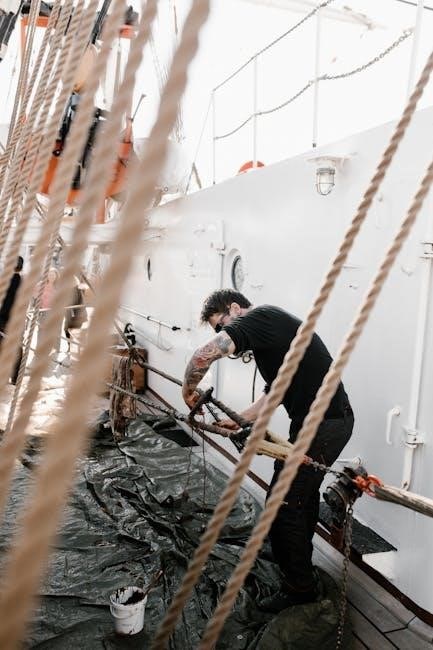
Key Components of the K2 Rigging System
- K2 WST enclosure: the core loudspeaker component.
- Rigging interfaces: including the K2-BUMP and LA-SLING2T.
- Accessories: designed for safe and efficient system deployment.
2.1. K2 WST Enclosure Overview
The K2 WST (WST stands for Wide Sound Travelling) enclosure is a lightweight, 3-way active loudspeaker designed for versatility in sound reinforcement applications. It features L-VENTS technology for even low-frequency distribution and PANFLEX for consistent directivity control. The enclosure is optimized for both touring and permanent installations, offering high SPL and precise coverage. Its compact design allows for seamless integration into various rigging configurations, ensuring flexibility and reliability. The K2 WST enclosure is central to the K2 system, providing the acoustic foundation for delivering high-quality sound in diverse environments, from theatres to large outdoor events.
2.2. Rigging Interfaces and Accessories
The K2 system is equipped with advanced rigging interfaces designed for secure and efficient setup. Key accessories include the K2-RIGBAR, LA-SLING2T, and K2-BUMP, which enable precise alignment and stability. These components ensure seamless integration with LA-RAK and K1-SB systems, allowing for ground-stacking or flying configurations. The rigging system is built with durable materials, such as steel with anti-corrosion coatings, to withstand demanding environments. Accessories like the K2-CHARIOT and K2-JACK facilitate easy transportation and tilt adjustments, enhancing the system’s portability. These interfaces and accessories are crucial for achieving optimal performance while maintaining safety standards during installation and operation.
2.3. K2-BUMP and LA-RAK Compatibility
The K2-BUMP is specifically designed to enhance the compatibility and stability of LA-RAK units when integrated with the K2 system. This accessory ensures secure mounting and alignment, allowing for seamless side-by-side configuration of LA-RAK enclosures. The K2-BUMP provides additional support for flying K2 arrays, ensuring even weight distribution and preventing structural strain. Its robust design complements the LA-RAK’s rigging capabilities, enabling precise adjustments for optimal sound coverage. This compatibility is crucial for maintaining the system’s integrity during installations, whether ground-stacked or flown, ensuring reliable performance and safety in various applications.
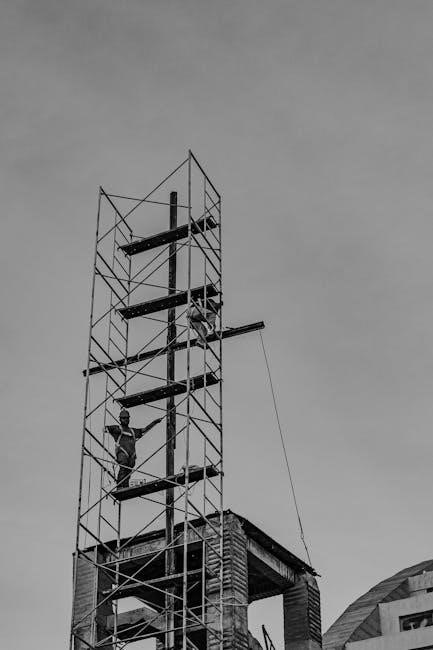
Understanding the K2 Rigging System
The K2 rigging system is designed for precise vertical assembly and angle adjustment, ensuring optimal sound coverage and structural integrity in various configurations and applications.
3.1. Mechanical Components and Their Functions
The K2 rigging system comprises several key mechanical components designed for safe and efficient assembly. The K2 WST enclosure serves as the core element, featuring integrated rigging points for secure connections. The rigging interfaces, including the LA-SLING2T and K2-BUMP, enable precise alignment and stabilization of the system. These components work together to facilitate vertical assembly and maintain optimal inter-element angles. The system also includes accessories like the K2-CHARIOT for transportation and the K2-RIGBAR for added stability. Each part is engineered to ensure durability and ease of use, with clear guidelines provided for their proper installation and maintenance to guarantee reliable performance in various applications.
3.2. Safety Considerations for Rigging
Safety is paramount when rigging the K2 system. Always adhere to L-Acoustics’ guidelines and use approved accessories to ensure system stability. Verify the Working Load Limit (WLL) of all components and avoid exceeding weight limits. Conduct regular inspections of mechanical parts, such as the LA-SLING2T and K2-BUMP, for signs of wear or damage. Properly secure all connections and ensure inter-element angles are set correctly to prevent instability. Use safety slings during assembly and avoid stacking enclosures beyond recommended heights. Follow pre-operation checklists and address any issues promptly to maintain a safe working environment. Regular maintenance and adherence to these precautions will help prevent accidents and ensure reliable performance.
3.3. Vertical Assembly and Inter-Element Angles
Vertical assembly of the K2 system requires precise alignment to achieve optimal acoustic performance. Use the K2-BUMP rigging interface to stack enclosures securely, ensuring inter-element angles are set between 0° and 10° for uniform coverage. Follow L-Acoustics’ guidelines to maintain stability and prevent structural stress. Always use approved accessories like the LA-SLING2T for safe and reliable connections. Refer to the manual for torque specifications and angle measurement techniques. Regular inspections of all mechanical components are crucial to ensure proper alignment and system integrity. Misalignment can lead to poor sound quality or safety hazards, so adherence to these procedures is essential for optimal results.
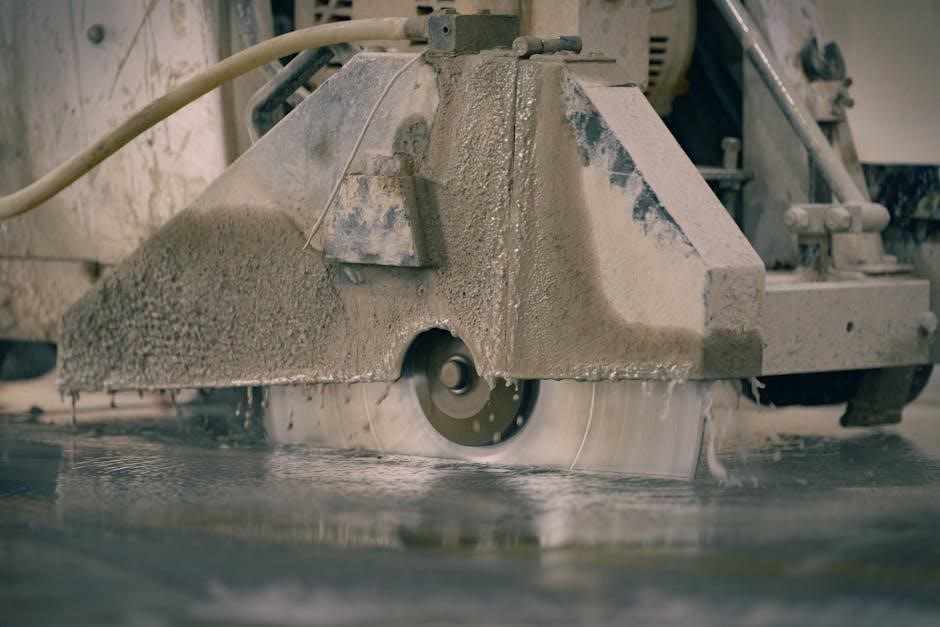
Safety Instructions and Precautions
Always read the manual and follow safety guidelines. Use approved rigging accessories and adhere to weight limits. Ensure proper training and regular inspections for safe operations.
4.1. General Safety Guidelines
Always read the K2 Rigging Manual thoroughly before attempting any rigging operations. Adhere to all safety instructions, warnings, and guidelines provided. Use only approved rigging accessories and ensure they are in excellent condition. Never exceed the specified weight and load limits for the system. Proper training and experience are essential for handling the K2 rigging system. Conduct regular inspections of all components, including cables, connectors, and structural elements. Ensure the system is properly grounded and stable to prevent accidents. Avoid stacking enclosures beyond recommended limits, and always use safety slings when flying the system. Failure to comply with these guidelines may result in serious injury or damage to the equipment.
4.2. Weight and Load Limits
Adhering to the specified weight and load limits is critical for safe and reliable operation of the K2 system. The K2 WST enclosure weighs approximately 3.3 kg / 7.3 lb, and the rigging system is designed to handle specific maximum loads. Exceeding these limits can lead to structural failure or accidents. Always refer to the K2 Rigging Manual for precise weight and load specifications. Use only approved accessories, and ensure all components are rated for the intended application. Regularly inspect rigging elements for wear or damage, and replace them as needed. Never use third-party equipment without verification of its compatibility and load capacity. Properly calculating and respecting these limits ensures the system’s stability and safety in all configurations.
4.3. Proper Use of Rigging Accessories
Using rigging accessories correctly is vital for the safe and efficient operation of the K2 system. Always follow the guidelines outlined in the K2 Rigging Manual to ensure compatibility and safety. The K2-BUMP and LA-RAK are essential components for secure rigging configurations. Use only approved accessories, such as the LA-SLING2T, to maintain system integrity. Ensure all components are properly attached and tightened according to the manufacturer’s specifications. Regularly inspect accessories for signs of wear or damage and replace them immediately if necessary. Proper use of rigging accessories ensures the system’s stability and prevents potential hazards during installation and operation. Always adhere to the recommended safety protocols to guarantee optimal performance and reliability.

Installation and Setup Procedures
This section outlines step-by-step procedures for installing and setting up the K2 system, including vertical assembly, inter-element angles, and using approved accessories for safe and optimal performance.
5.1. Step-by-Step Rigging Assembly
To begin, ensure all components are inspected and approved for use. Start by attaching the K2-BUMP to the flown array, ensuring proper alignment. Next, connect the LA-RAK units securely, following the manual’s torque specifications. Use the rigging bar to stabilize the system and ensure even weight distribution. Attach the pullback system to maintain inter-element angles, adjusting as needed for optimal sound coverage. Finally, perform a thorough safety check, verifying all connections and ensuring the system is level and balanced. Always refer to the rigging manual for specific torque values and assembly sequences to guarantee safe and accurate installation.
5.2. Configuring the System for Different Applications
The K2 system offers flexibility for various applications, from live concerts to permanent installations. For flown systems, use the K2-BUMP to maintain precise inter-element angles, ensuring even coverage. Ground-stacked configurations can incorporate the LA-RAK for stability and optimal low-frequency response. Adjust the rigging bar and pullback to customize the array’s curvature for different venues. For theater setups, integrate the K2 with subwoofers like the KS28 for enhanced bass. Utilize Soundvision software to design and predict system performance. Always refer to the rigging manual for specific configurations and ensure compliance with safety guidelines for each setup.
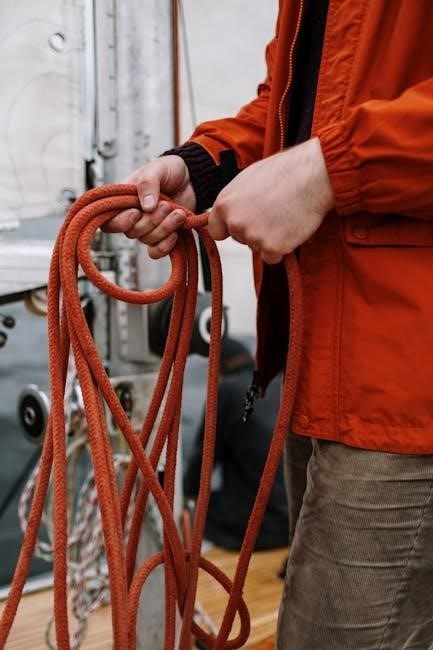
5.3. Ground-Stacking and Flying the System
Ground-stacking the K2 system involves using the LA-RAK or K2-BUMP to stabilize the array, ensuring proper weight distribution and alignment. For flying, the K2 rigging bar and pullback system allow precise adjustment of inter-element angles, maintaining uniform coverage. Always use approved accessories like the LA-SLING2T for safe suspension. Ensure the system is balanced and securely attached to prevent instability. Regularly inspect all rigging components for wear or damage. Follow the rigging manual for detailed procedures and safety guidelines to ensure reliable operation in both ground-stacked and flown configurations.

Maintenance and Inspection
Regular maintenance checks ensure the K2 system’s optimal performance and safety. Inspect rigging components, cables, and hardware for wear or damage, and replace parts as needed promptly.
6.1. Regular Maintenance Checks
Regular maintenance checks are crucial for ensuring the longevity and reliability of the L-Acoustics K2 rigging system. Inspect all rigging components, including cables, pins, and hardware, for signs of wear, corrosion, or damage. Verify that all connections are secure and properly tightened. Check the condition of the enclosures, ensuring no damage or structural compromise. Refer to the K2 rigging manual for detailed inspection procedures. Schedule routine maintenance before and after major tours or installations to prevent potential issues. Replace any damaged or worn parts immediately, using only approved L-Acoustics accessories. Maintain accurate records of inspections and servicing for future reference and compliance with safety standards.
6.2. Inspecting Rigging Components
Inspecting rigging components is a critical step in maintaining the safety and efficiency of the L-Acoustics K2 system. Begin by visually examining all hardware, including pins, cables, and brackets, for signs of wear, corrosion, or damage. Ensure that all connections are secure and properly aligned. Check the condition of the rigging bar, pullback, and other accessories for any deformation or degradation. Verify that all components are free from dirt, dust, or other contaminants that could compromise their integrity. Use a torque wrench to ensure all bolts and screws meet the specified torque values outlined in the K2 rigging manual. Replace any damaged or worn parts immediately with approved L-Acoustics accessories to prevent potential safety hazards.
6.3. Replacing Damaged or Worn Parts
Replacing damaged or worn parts is essential to ensure the safe and optimal operation of the L-Acoustics K2 rigging system. Always use genuine L-Acoustics replacement parts to maintain the system’s integrity and performance. Before replacing any component, thoroughly inspect the affected area to identify the extent of the damage. Use tools and accessories approved by L-Acoustics to avoid compromising the rigging system. Follow the torque specifications provided in the K2 rigging manual when tightening bolts and screws. If a part is complex to replace, refer to the manual or consult a certified technician. Document the replacement for future maintenance records and ensure all safety guidelines are adhered to during the process.
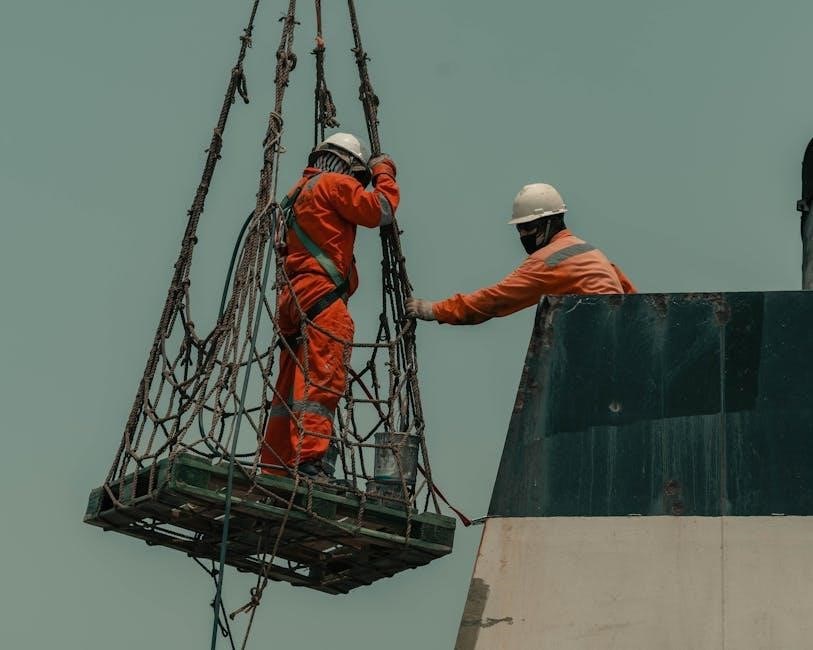
Troubleshooting Common Issues
Identify and resolve common rigging issues such as mechanical malfunctions or connectivity problems. Refer to diagnostic techniques and guidelines for optimal system performance and safety compliance.
7.1. Identifying and Addressing Rigging Problems
Identifying rigging issues early ensures system reliability and safety. Inspect all components for wear, damage, or misalignment. Common problems include loose connections, corroded parts, or incorrect inter-element angles. Address these by tightening fittings, replacing damaged components, and verifying angle settings. Use diagnostic tools to detect mechanical malfunctions. Always follow the K2 rigging manual’s guidelines for troubleshooting. If issues persist, consult L-Acoustics support for specialized assistance. Regular maintenance and adherence to safety protocols minimize risks and ensure optimal performance. Proper documentation of repairs and inspections is crucial for long-term system integrity.
7.2. Resolving Mechanical Malfunctions
Resolving mechanical malfunctions in the K2 rigging system requires careful diagnosis and adherence to L-Acoustics guidelines. Start by identifying the source of the issue, such as loose connections or worn components. Use diagnostic tools like torque wrenches to ensure all fittings are secure. If damage is found, replace parts with L-Acoustics-approved accessories to maintain system integrity. Lubricate moving parts if necessary and verify alignment after repairs. For persistent issues, consult the rigging manual or contact L-Acoustics support for specialized assistance. Always follow safety protocols to prevent further damage or risks. Proper resolution ensures optimal performance and longevity of the rigging system. Regular maintenance checks are crucial to prevent mechanical malfunctions.
7.3. Diagnostic Techniques for Optimal Performance
Diagnosing issues in the K2 rigging system involves a systematic approach to ensure optimal performance. Begin with a visual inspection of all mechanical components, checking for wear, damage, or misalignment. Use diagnostic tools like torque wrenches to verify proper tightening of bolts and fittings. Inspect rigging accessories, such as slings and shackles, for signs of fatigue or corrosion. Refer to the rigging manual for specifications and tolerances. Perform functional tests, such as moving components through their range of motion, to identify any restrictions or malfunctions. Address any findings promptly by replacing worn parts or adjusting components as needed. Regular diagnostic checks ensure reliable operation and prevent potential failures during use. Always follow L-Acoustics guidelines for accurate diagnostics.

Compliance and Manufacturer Guidelines
Adhere strictly to L-Acoustics’ recommendations for rigging and maintenance to ensure system integrity and safety. Use only approved accessories to maintain warranty validity and avoid liability issues.
8;1. Adhering to L-Acoustics Recommendations
Strictly following L-Acoustics’ guidelines ensures optimal performance, safety, and compliance with industry standards. Always use approved rigging accessories like the LA-SLING2T and K2-RIGBAR to maintain system integrity. Avoid third-party equipment unless explicitly authorized, as it may void warranties or compromise safety. Regular maintenance, as outlined in the manual, is crucial for preventing wear and tear. Failure to adhere to these recommendations can lead to mechanical failures, safety hazards, and potential liability issues. L-Acoustics provides detailed procedures for rigging, stacking, and flying systems, ensuring reliability and consistency across all applications. By adhering to these guidelines, users can maximize the lifespan and performance of the K2 system while ensuring operational safety.
8.2. Using Approved Accessories and Equipment
Using only L-Acoustics-approved accessories ensures compatibility, safety, and optimal system performance. Accessories like the LA-SLING2T and K2-RIGBAR are specifically designed for the K2 system, guaranteeing reliability and adherence to safety standards. Unauthorized equipment may compromise system integrity, leading to mechanical failures or safety hazards. Always verify the Working Load Limit (WLL) of rigging components and ensure they meet L-Acoustics’ specifications. Using unapproved equipment can void warranties and increase liability risks. Adhering to these guidelines ensures the system operates as intended, providing consistent performance and reliability across all applications;
8.3. Warranty and Liability Information
L-Acoustics provides a warranty covering manufacturing defects for the K2 system and its components. However, this warranty does not extend to third-party equipment or unauthorized modifications. Using unapproved accessories or rigging equipment voids the warranty and increases liability risks. The manufacturer is not responsible for damages resulting from misuse or non-compliance with the rigging manual. Users must adhere to specified guidelines to maintain warranty validity. For detailed terms and conditions, refer to the official warranty document provided with the system. Proper use and adherence to L-Acoustics recommendations ensure optimal performance and safety, minimizing potential liabilities.
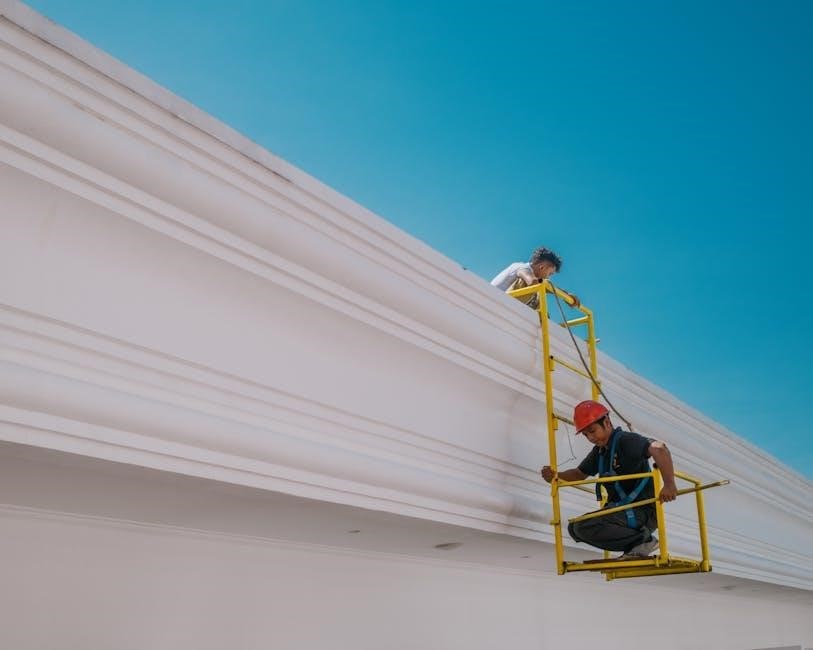
The K2 rigging manual ensures safe and effective system deployment. Always follow checklists for pre-operation and post-operation to maintain optimal performance and compliance with safety standards.
9.1. Summary of Key Rigging Procedures
The K2 rigging manual outlines critical steps for safe and efficient system deployment. Begin with thorough pre-operation checks, ensuring all components are secure and undamaged. Adhere to weight and load limits, using only approved accessories. Properly configure inter-element angles and stabilize the system to prevent instability. Follow detailed assembly and disassembly procedures, ensuring all safety slings and rigging bars are correctly engaged. Regular maintenance is essential to uphold performance and safety standards. Always refer to the manual for specific guidelines on ground-stacking, flying, and configuring the system for various applications. By following these procedures, users can ensure reliable operation and compliance with L-Acoustics recommendations.
9.2. Pre-Operation and Post-Operation Checklists
Pre-operation checks ensure the K2 system is safe and ready for use. Inspect all rigging components, verify correct assembly, and ensure load limits are respected. Test all mechanical connections and safety slings. Post-operation, secure the system to prevent accidental movement and verify no damage occurred during use. Document any issues and schedule maintenance if needed. These checklists help maintain system integrity, ensuring optimal performance and longevity. Always follow the manual’s detailed procedures for both pre and post-operation tasks. Proper adherence guarantees safety and reliability, aligning with L-Acoustics’ quality standards; Regular checks prevent potential issues, ensuring the K2 system performs flawlessly in any setting.
9.3. Resources for Further Assistance
For additional support, refer to the official L-Acoustics K2 Rigging Manual and supplementary guides available on the L-Acoustics website. Contact L-Acoustics technical support for personalized assistance. Utilize the SOUNDVISION software for advanced system design and modeling. Engage with the L-Acoustics community forum for peer-to-peer troubleshooting and best practices. Regularly check the L-Acoustics Documentation Center for updated manuals and resources. These tools ensure comprehensive support for optimal K2 system performance and safe rigging practices.










